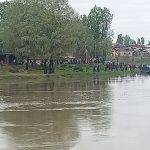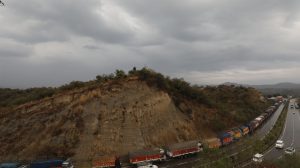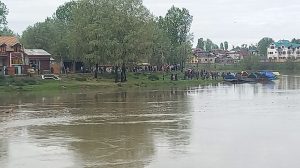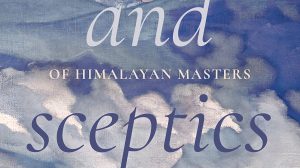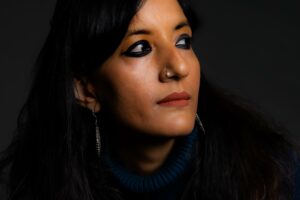The book “Blue Sky, White Cloud: Three Novellas” by Nirmal Ghosh features beautiful illustrations and rich prose.
The novellas in this book are ‘River Storm’, ‘Spirit of The Hills’, and ‘Blue Sky, White Cloud’.
In the novella ‘Blue Sky, White Cloud’, Nadia, a wildlife biologist researching geese, travels to Mongolia, where she tags two geese: Blue Sky and White Cloud. As the birds fly southwards over the Himalayas, she meets Vivek, India’s Minister of State for Environment. Their instantaneous friendship soon takes Vivek to a lush valley at the base of the soaring Himalayas, where he must make a decision that will impact the lives of all around him.
Read an excerpt from the book below.
The wild geese know when winter is coming.
Maybe it is in the quickening of days. Or a change in the wind.
Flying across the vast undulating plains of Mongolia etched with jagged mountains, where you can see the curvature of the earth in the great distance as it slopes away over the horizon, with only a thin skin of sky between you and the universe, perhaps they feel it a little bit each day as the earth orbits the sun.
They feel it in the winds from the tundra, from the woods and the plains and freezing rivers around Novosibirsk, that seep south blowing flurries of snow through the rocky gorges of the Altai.
It is an early morning chill in the blue air that the bar-headed geese, and the demoiselle cranes, and the herdsmen warming their rough calloused hands on wood fires, recognize.
And everyone knows the snowstorms that will follow.
****
Through the summer the bar-headed geese, feeding amid the sedges of the lakes whose still waters mirror a cobalt sky, beat their wings, facing the sun, thinking they will live forever.
Here all summer, among the cranes and greylag geese and pintails and gadwalls and blue winged teal and painted snipe, they have been feeding and breeding, on islands and on cliff slopes, and talking among themselves. All the while they have eyed the sky for the distant speck or shadow of a wing, perhaps of a steppe eagle, or a golden eagle, which can strike out of nowhere, out of the sun like a missile at the last split second, legs outstretched with deadly talons extended to grip the kill.
But the geese in their flocks at any given moment have eyes across the sky, and once the eagle is spotted there is far less chance for it to mount a successful strike. The flocks will rise as one with a great power of wings, fighting back with noise and a threatening confusion.
An even greater number scan the plains for the marauding ash grey corsac fox and red fox, or the trample of the cattle and the dogs of the nomadic herdsmen on their horses—all a danger to their eggs and fledglings on the ground.
And then, one day in autumn, as the daylight hours grow shorter, well fed with the rich nutrients of the wetlands and crops of wheat and barley, the geese, and cranes, and a myriad others— snipe, teal, pied wagtail—take flight singly or in groups. Wheeling around the blue lake as if taking a last look, they straighten out and climbing high into the thin air, turn south.
The bar-headed geese fly the highest.
Over the course of the next month or two they will fly thousands of kilometres to the warmer plains of India.
Some migratory birds travel around the great barriers of the high Himalayas. Some fly through the mountains, using the deep gorges.
The bar-headed geese fly over them.
The journey is long, and hazardous, with just a few stops along the way in high altitude lakes and marshes and farmland.
****
That particular autumn, Bayar had help in the form of the young woman from India who had flown up from the south on a grant to help with the tracking project. Nadia Qureshi, a wildlife biologist with a PhD on common cranes in Kutch, in western India, had flown from New Delhi, and joked when she arrived in Ulaanbaatar that she had probably traced the winter migratory route of the geese already at jet speed and in the wrong direction.
Bayar at seventy was still strong but had slowed down, and so he was glad for the help from the tall and fit thirty-five year old whom he insisted on calling not Nadia but, very formally, Dr Qureshi, even if he could only communicate with her in his imperfect English.
After a day of mostly driving, in an old Land Rover Defender with a chatty driver, during which she picked up supplies as well, Nadia had reached Bayar’s camp in the slow honey light of evening.
Bayar is a common name in Mongolia, but everyone in the circles that Nadia frequented referred to him by only that name, for in those circles there was only one possible person you could be referring to if you mentioned that name.
Bayar was alone but for a young nephew whose job was mainly to look after their three horses, one of which was for Nadia.
The camp was organized. Bayar was used to having visitors from all over the world. She would have her own round tent, what the Mongolians call a ger and Russians call a yurt. And there were two toilet tents, one exclusively for her. He grunted approvingly when he saw the supplies she had brought. The fresh fruit was especially appreciated.
She would not be there long. The next morning they set out on two horses, with the third carrying the gear needed for the operation.
Their destination was a two-hour ride away across soft ground and through a narrow pass between jagged rocks. The Land Rover would not be able to make this last leg because of the boggy ground; only the horses could. The driver and Bayar’s nephew stayed behind.
On the back of the third horse were stacked bags and boxes containing fine nylon nets and nooses, tags and telemetry equipment for the project. They plodded through patches of marsh and picked their way over rocky ridges as the sun climbed above, warming them.
Around mid-afternoon they reached the field camp, which was similar to base camp but had fewer comforts, designed only for transient overnight stays. But Bayar wanted them to stay a full day and two nights just to be safe, so that the bar-headed geese in the marsh would get used to their presence. That would make their job easier. He told Nadia he had scattered some grain a few days previously, to help gather the geese in an area ideal for catching them. It would still help if they were not skittish at their presence, he said.
He tapped a finger on the side of his forehead. ‘Geese, they know who is who,’ he said.
They ate horse meat that night by the fire. Later, when the flames had died down, Nadia took pictures of the full moon, its cratered surface startlingly clear in the thin air.
Around them in the vastness there was no sound. She slept well.

Excerpted with permission from Blue Sky, White Cloud: Three Novellas, Nirmal Ghosh, Aleph Book Company. Read more about the book here and buy it here.





